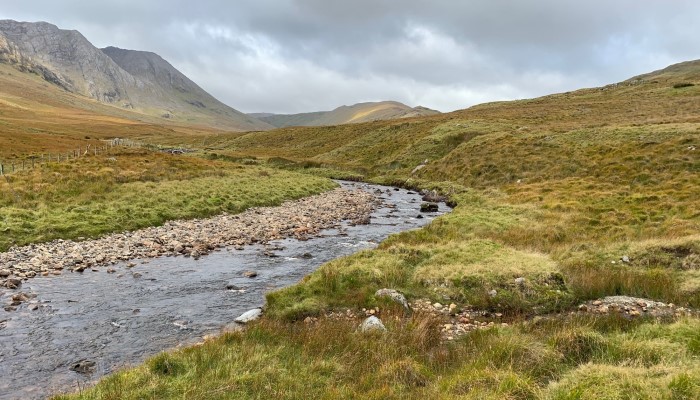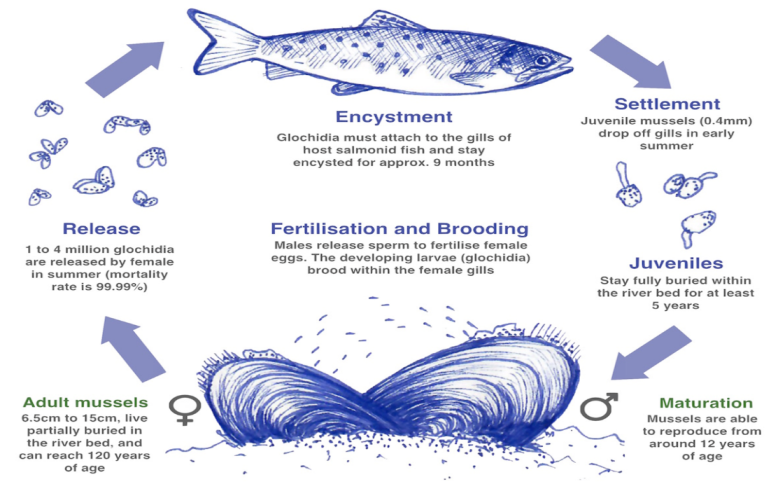25 March 2021
Water Quality and the Freshwater Pearl Mussel

The freshwater pearl mussel (Margaritifera margaritifera) is a large filter-feeding bivalve. European freshwater pearl mussel populations have declined by 90 % over the past century. Mary McAndrew, Catchment Officer Pearl Mussel Project gives information on this long lived creature.
Freshwater pearl mussels are extremely long lived and are capable of surviving for up to 140 years.This makes them Ireland’s longest living animal.
Adult freshwater pearl mussels can reach lengths of 12-15 cm. They live buried, or partially buried in the river bed. Freshwater pearl mussels are filter feeders, inhaling and expelling up to 50 L of water per day through siphons, while retaining food particles. This filtering activity means that pearl mussels can help to maintain and improve water quality, where they are present in high numbers.

Lifecycle of Freshwater Pearl Mussel
European freshwater pearl mussel populations have declined by 90 % over the past century. In Ireland, 27 freshwater pearl mussel populations are protected within Special Areas of Conservation (SACs). Eight of these populations contain 80 % of the total Irish freshwater pearl mussel population and occupy what are known as the ‘Top 8 catchments’. While the ‘Top 8 catchments’ support the highest remaining numbers of freshwater pearl mussels in Ireland, these populations are also undergoing a slow decline, and face extinction unless action is taken. The Pearl Mussel Project EIP was set up to support farmers in these Catchments to improve and protect water quality through a result based payment system.
Threats to Freshwater Pearl Mussel
The main reason for decline is the low survival rate of juvenile mussels, which are extremely sensitive to slight changes in environmental conditions. This is leading to an ageing population, not capable of replenishing itself. Juvenile survival is dependent on a clean, well oxygenated river bed, with little silt, sediment, or algal growth.
Any activities that result in changes in river flow, increased levels of silt, and increased levels of nutrients are contributing to the decline of freshwater pearl mussels. In addition drainage and increased intensification of land use in river catchment areas can contribute to inadequate conditions for freshwater pearl mussel survival.
The Pearl Mussel Project are currently working with over 450 farmers throughout the Top 8 Catchments. With the help trained farm advisors the project assesses each farm annually using habitat and whole-farm scorecards. Farmers are financially rewarded according the scores achieved. Through this results-based payment approach farmers are incentivised to improve the habitat condition and water quality throughout their farms. Ultimately the project pays farmers to produce clean water and the delivery of other benefits to biodiversity and climate.
The main agricultural pressures to water courses within the top 8 catchments include:
- Changes in flow and hydrology due to land drainage and habitat conversion.
- Sediment losses to watercourses due to excessive poaching and animal access to rivers and streams.
- Nutrient run-off to watercourses due to inappropriate use of fertilisers.
The Pearl Mussel project encourages farmers to manage their habitats for the benefit of water, carbon, and biodiversity. A major part of the programme involves raising awareness amongst participant farmers through ongoing training and engagement.
This video gives more detail on the Freshwater Pearl Mussel project
View more content from Water Quality Week here
